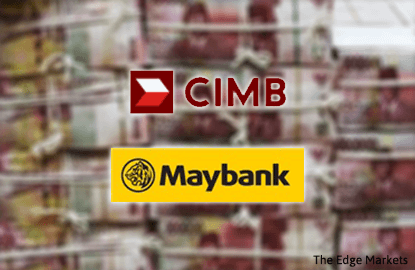
This article first appeared in The Edge Malaysia Weekly, on February 29 - March 6, 2016.
CIMB Group Holdings Bhd and Malayan Banking Bhd (Maybank) turned in contrasting sets of results for their respective Indonesian operations in the financial year ended Dec 31, 2015 (FY2015).
While PT Bank CIMB Niaga’s earnings remained weak, dragged down by high loan provisions, PT Bank Maybank Indonesia’s saw a big improvement. Nevertheless, asset quality deteriorated for the latter, which was formerly known as Bank Internasional Indonesia.
As such, banking analysts continue to be concerned over both lenders as they expect provision levels to stay high in FY2016, given the anticipated slowdown in Indonesia’s economic growth. Their concern is more for CIMB Niaga, which contributes a substantial portion of its parent company CIMB Group’s earnings, compared with Maybank Indonesia.
“Concerns on asset quality among Indonesian banks are not over yet, though our base case assumes a period of stability in the second half of 2016. Commodities-related sectors remain at risk while we are increasingly seeing a spillover effect on the manufacturing sector,” writes DBS Group Research in a Feb 25 report. “Meanwhile, Indonesian regulators’ initiative of lowering lending rates could be another bane to the sector should a net interest margin (NIM) cap regulation be implemented.”
Other analysts also note that asset quality issues are expected to persist in Indonesia as economic growth slows and automotive and property sales drop, on top of a weaker Indonesian rupiah.
CIMB Niaga’s core net profit (after stripping off one-off items) fell 59.3% to IDR856 billion in FY2015. The one-off items include IDR471 billion in expenses from a mutual separation scheme (MSS) as well as IDR100 billion expenses from recalibrating its micro business loans.
The decline in core earnings was largely due to higher provisions — up 54.7% year on year — mainly from the impairment of coal and coal-related loans. Its fourth-quarter core net profit slipped 46.1% to IDR238 billion.
CIMB-Niaga’s gross non-performing loan (NPL) ratio increased to 3.74% as at December 2015 from 3.17% three months before. “Note that these figures are post-NPL sale into a ‘bad bank’ (in the previous quarter). Including this, its NPL ratio would have been closer to 5%,” DBS Group Research notes.
Still, despite CIMB Niaga’s lacklustre results, it did not hurt CIMB Group’s earnings performance in FY2015 as much as expected, given that the Malaysian parent’s results were held up by better-than-expected investment income.
CIMB Group, which announced its full-year results last Thursday, turned in a core net profit of RM3.4 billion — up 8% from a year ago — that was in line with analysts’ consensus estimates.
“CIMB Niaga’s earnings fell short of expectations, but this was compensated by higher-than-expected investment income at the [CIMB] group level. Stripping out its mutual separation scheme costs, [CIMB Group] saw positive JAWS [banking jargon for income growth exceeding expense growth] for the first time in four years, which partly buffered the jump in credit costs,” Maybank Investment Bank Research says in a note.
CIMB Niaga accounted for just 9% of the group’s profit before tax (PBT) in FY2015 compared with 19% in the previous year. In the past, it used to make up as much as 30% of PBT. The contribution from CIMB Niaga declined significantly after it started being plagued by high provisions in the fourth quarter of FY2014.
“We expect CIMB Niaga’s performance to remain dismal at least until the first half of 2016,” DBS Group Research says.
Following the results, several research houses cut their FY2016 earnings forecasts slightly for CIMB Group to factor in higher credit cost. However, they did note an improvement in CIMB’s Common Equity Tier-1 (CET-1) ratio, which helps ease earlier concerns about the group possibly having to resort to a rights issue to raise funds.
“The one major positive this quarter has been the improvement in CIMB’s fully-loaded CET-1 ratio to about 10.1% (from 9.1% at end-September 2015). This alleviates some of the concerns over the possible need to raise funds in the medium term, for the group’s 11% target appears within reach,” says Maybank IB Reseasrch.
Over at Maybank, Maybank Indonesia’s net profit for FY2015 grew by a strong 60.9% to IDR1.14 trillion. The improved profit was driven mainly by a 41% increase in non-interest income, which grew on the back of strong fee and commission income as well as forex transactions at its treasury division.
Net interest income too grew by 9%, supported by higher NIM — up by eight basis points — and moderate loan growth of 5.9%. In the final quarter, net profit grew 168% to IDR547 billion.
However, provisions remained elevated, mainly due to weaker asset quality in corporate loans. Provision expenses grew 28% to IDR2.29 billion. Maybank Indonesia’s gross NPL ratio stood at 3.67% as at end-December, and while this was an improvement over the preceding quarter’s 4.21%, it was nevertheless a deterioration from the 2.23% seen a year ago. The gross impaired loan ratio, however, trended lower to 3.83% in 4Q15 compared with 4.65% in 3Q15.
“We understand that this has been contributed partly by its active restructuring of loans. [Maybank Indonesia] remains cautious over asset quality and is focusing on reducing its exposure to corporate loans that have resulted in the rise in NPLs,” MIDF Research says.
Maybank’s full-year net profit rose by a marginal 1.78% to RM6.84 billion, underpinned by strong net operating income growth of 14.6% to RM21.24 billion. Stronger revenue was mitigated by higher provisions. Its final quarter net profit fell 14.5% to RM1.65 billion as it booked higher impairment losses amid the tougher economic environment.
“The outlook remains murky for CIMB Group and Maybank, for both their domestic and regional operations. On top of the challenges in Indonesia, slower loan growth and weak capital markets could cap revenue growth in Malaysia,” says DBS Group Research.
Save by subscribing to us for your print and/or digital copy.
P/S: The Edge is also available on Apple's AppStore and Androids' Google Play.